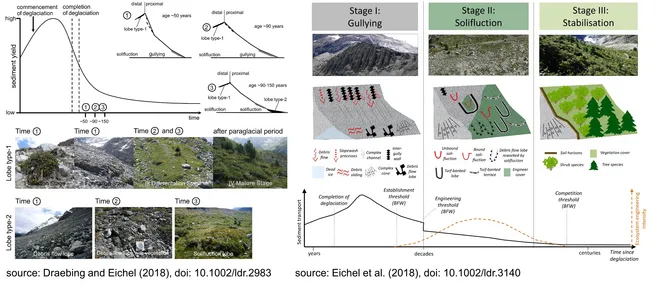Daniel Draebing recently published two studies on the development of Alpine lateral moraine slopes in the special issue “Paraglacial processes in recently deglaciated environments” in the journal “Land Degradation and Development” (IF 7.27). Fieldwork for both studies were conducted within the German Research Foundation funded project BIMODAL in 2014 and 2015.
The first study (Draebing and Eichel, 2018) is a work together with Jana Eichel (Karlsruhe Institute of Technology, KIT) and focuses on the divergent and path-dependent reworking of lateral moraines by paraglacial processes (left figure). The study shows that (1) different types and genesis of solifluction lobes exist on lateral moraines, (2) paraglacial adjustment of distal and proximal moraine slopes is diverging due to solifluction which results (3) in equifinality of solifluction lobes on glacial till and debris flow deposits. The latter has (4) implications on abductive reasoning of solifluction sheet development at the end of the last glaciation.
The second study (Eichel et al., 2018) is co-production with Jana Eichel (KIT) and Nele Meyer (University of Helsinki) and focuses on the paraglacial transition of Alpine lateral moraine slopes. The study shows that ecosystem engineering plays a role in paraglacial adjustment, which follows a path-dependent trajectory. Furthermore, the study presents a conceptual 3-stage model of paraglacial adjustment (right figure).
